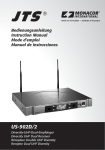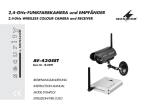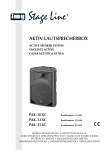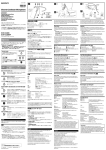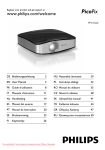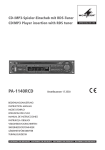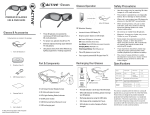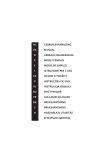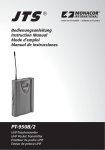Download 2-kanal-multifrequenz-empfänger für funkmikrofone
Transcript
2-KANAL-MULTIFREQUENZ-EMPFÄNGER FÜR FUNKMIKROFONE 2-CHANNEL MULTI-FREQUENCY RECEIVER FOR WIRELESS MICROPHONES RÉCEPTEUR MULTI-FRÉQUENCES 2 CANAUX POUR MICROPHONES SANS FIL RICEVITORE MULTIFREQUENZA A 2 CANALI PER RADIOMICROFONI 672,000 – 696,975 MHZ TXS-626 Bestellnummer 25.3520 BEDIENUNGSANLEITUNG • INSTRUCTION MANUAL • MODE D’EMPLOI ISTRUZIONI PER L’USO • MANUAL DE INSTRUCCIONES • INSTRUKCJA OBSŁUGI D Bevor Sie einschalten … A Wir wünschen Ihnen viel Spaß mit Ihrem neuen Gerät von „img Stage Line“. Bitte lesen Sie diese Bedienungsanleitung vor dem Betrieb gründlich durch. Nur so lernen Sie alle Funktionsmöglichkeiten kennen, vermeiden Fehlbedienungen und schützen sich und Ihr Gerät vor eventuellen Schäden durch unsachgemäßen Gebrauch. Heben Sie die Anleitung für ein späteres Nachlesen auf. We wish you much pleasure with your new “img Stage Line” unit. Please read these operating instructions carefully prior to operating the unit. Thus, you will get to know all functions of the unit, operating errors will be prevented, and yourself and the unit will be protected against any damage caused by improper use. Please keep the operating instructions for later use. Der deutsche Text beginnt auf der Seite 4. The English text starts on page 6. CH GB Before switching on … F Avant toute installation … B Nous vous souhaitons beaucoup de plaisir à utiliser cet appareil “img Stage Line”. Lisez ce mode dʼemploi entièrement avant toute utilisation. Uniquement ainsi, vous pourrez apprendre lʼensemble des possibilités de fonctionnement de lʼappareil, éviter toute manipulation erronée et vous protéger, ainsi que lʼappareil, de dommages éventuels engendrés par une utilisation inadaptée. Conservez la notice pour pouvoir vous y reporter ultérieurement. Vi auguriamo buon divertimento con il vostro nuovo apparecchio di “img Stage Line”. Leggete attentamente le istruzioni prima di mettere in funzione lʼapparecchio. Solo così potete conoscere tutte le funzionalità, evitare comandi sbagliati e proteggere voi stessi e lʼapparecchio da eventuali danni in seguito ad un uso improprio. Conservate le istruzioni per poterle consultare anche in futuro. La version française se trouve page 8. Il testo italiano inizia a pagina 10. CH E Antes de la utilización … Le deseamos una buena utilización para su nuevo aparato “img Stage Line”. Por favor, lea estas instrucciones de uso atentamente antes de hacer funcionar el aparato. De esta manera conocerá todas las funciones de la unidad, se prevendrán errores de operación, usted y el aparato estarán protegidos en contra de todo daño causado por un uso inadecuado. Por favor, guarde las instrucciones para una futura utilización. I PL Prima di accendere … Przed uruchomieniem … Życzymy zadowolenia z nowego produktu “img Stage Line”. Dzięki tej instrukcji obsługi będą państwo w stanie poznać wszystkie funkcje tego urządzenia. Stosując się do instrukcji unikną państwo błędów i ewentualnego uszkodzenia urządzenia na skutek nieprawidłowego użytkowania. Prosimy zachować instrukcję. Tekst polski zaczyna się na stronie 14. La versión española comienza en la página 12. www.imgstageline.com 2 GROUP CHANNEL VOL 1 9 3 2 3 45 6 10 GROUP CHANNEL VOL 7 3 11 12 13 10 8 D A Auf der ausklappbaren Seite 3 finden Sie alle beschriebenen Bedienelemente und Anschlüsse. CH 1 Übersicht der Bedienelemente und Anschlüsse Im folgenden Text wird nur das Empfangsteil 1 (RECEIVER 1) beschrieben. Die Bedienung des Empfangsteils 2 ist identisch. 1 IR-Fenster für die Infrarotsignale zur Kanaleinstellung des Funkmikrofons / Taschensenders 2 Taste ACT 1. Zum Aussenden der Infrarotsignale für die Kanaleinstellung des Funkmikrofons / Taschensenders die Taste kurz drücken. 2. Zum automatischen Suchen eines freien Empfangskanals die Taste solange drücken, bis im Display die äußeren Anzeigesegmente der Ziffern für GROUP und CHANNEL rechtsherum laufen. 2 Hinweise für den sicheren Gebrauch 4 Inbetriebnahme Die Geräte (Empfänger und Netzgerät) entsprechen allen relevanten Richtlinien der EU und sind deshalb mit gekennzeichnet. 4.1 Empfänger aufstellen, anschließen und einschalten WARNUNG Das Netzgerät wird mit lebensgefährlicher Netzspannung versorgt. Nehmen Sie deshalb niemals selbst Eingriffe an diesem Gerät vor. Es besteht die Gefahr eines elektrischen Schlages. Beachten Sie auch unbedingt die folgenden Punkte: G Die Geräte sind nur für die Verwendung im Innenbereich geeignet. Schützen Sie sie vor Tropf- und Spritzwasser, hoher Luftfeuchtigkeit und Hitze (zulässiger Einsatztemperaturbereich 0 – 40 °C). G Stellen Sie keine mit Flüssigkeit gefüllten Gefäße, z. B. Trinkgläser, auf die Geräte. G Nehmen Sie den Empfänger nicht in Betrieb und ziehen Sie sofort das Netzgerät aus der Steckdose, 1. wenn sichtbare Schäden am Empfänger oder am Netzgerät vorhanden sind, 2. wenn nach einem Sturz oder Ähnlichem der Verdacht auf einen Defekt besteht, 3. wenn Funktionsstörungen auftreten. Lassen Sie die Geräte in jedem Fall in einer Fachwerkstatt reparieren. 3 Empfangsantennen A und B 4 Tasten und zum Einstellen der Kanalgruppe, der Kanalnummer und des Mischverhältnisses der Mikrofonsignale 5 Taste SET: Soll die Kanalgruppe, die Kanalnummer oder das Mischverhältnis der Mikrofonsignale an der Buchse SUM OUT (11) geändert werden, die Taste SET so oft drücken, bis im Display (6) die zugehörigen Ziffern blinken. Solange die Ziffern blinken, mit den Tasten und (4) die Einstellung vornehmen. 6 Display zur Anzeige 1. der Kanalgruppe (GROUP 00 – 09) 2. des Kanals (CHANNEL 00 – 99) 3. des eingestellten Signalpegels (VOL 00 – 63), mit dem das Mikrofonsignal des zugehörigen Empfangsteils auf die Buchse SUM OUT (11) gemischt wird 4. der HF-Signalstärke ( ) 5. welche der beiden Antennen das stärkere Funksignal empfängt, angezeigt durch das linke oder rechte Antennensymbol 7 Pegelanzeige AF (audio frequency) für das empfangene Tonsignal 8 Ein- und Ausschalter POWER 1. Zum Einschalten die Taste solange drücken, bis die Displays aufleuchten. 2. Zum Ausschalten die Taste solange drücken, bis die Displays OFF anzeigen. 9 Stromversorgungsbuchse zum Anschluss des beiliegenden Netzgerätes 10 Antennenbuchsen 11 Audioausgang (6,3-mm-Klinke) für das Mischsignal der Empfangsteile 1 und 2 zum Anschluss an einen Line-Eingang 12 XLR-Audioausgang zum Anschluss an einen Mikrofoneingang 13 Regler SQUELCH zum Einstellen der Ansprechschwelle für die Störunterdrückung G Verwenden Sie für die Reinigung nur ein trockenes, weiches Tuch, niemals Wasser oder Chemikalien. G Werden die Geräte zweckentfremdet, nicht richtig angeschlossen, falsch bedient oder nicht fachgerecht repariert, kann keine Haftung für daraus resultierende Sach- oder Personenschäden und keine Garantie für die Geräte übernommen werden. Sollen die Geräte endgültig aus dem Betrieb genommen werden, übergeben Sie sie zur umweltgerechten Entsorgung einem örtlichen Recyclingbetrieb. 3 Einsatzmöglichkeiten Der Multifrequenz-Empfänger TXS-626 bildet in Verbindung mit zwei Funkmikrofonen ein zweikanaliges drahtloses Audio-Übertragungssystem, das speziell für Musiker und den Live-Einsatz auf der Bühne geeignet ist. Der True-Diversity*Empfänger arbeitet im UHF-Frequenzbereich 672,000 – 696,975 MHz. Die Frequenz für die Audioübertragung lässt sich innerhalb dieses Bereiches einstellen (Frequenzraster 25 kHz). Folgende Funkmikrofone von „img Stage Line“ können zusammen mit dem TXS-626 betrieben werden: TXS-606HT Bestellnummer 25.3540 Handmikrofon mit integriertem MultifrequenzSender TXS-606LT Bestellnummer 25.3550 Multifrequenz-Taschensender mit Krawattenmikrofon Besonders komfortabel ist die Frequenzeinstellung durch die ACT-Funktion (Automatic Channel Targeting). Damit wird per Knopfdruck über ein Infrarotsignal das Funkmikrofon / der Taschensender auf den am Empfänger gewählten Kanal eingestellt. * True-Diversity-Technik: Das vom Funkmikrofon / Taschensender ausgestrahlte Signal wird von zwei Antennen empfangen und in zwei separaten Empfangsteilen verstärkt. Das jeweils besser empfangene Signal wird dann weiterverarbeitet. 4 1) Der Empfänger ist für die Montage in ein Rack (482 mm /19″) vorgesehen, kann aber auch als frei stehendes Tischgerät verwendet werden. Für den Einbau in ein Rack wird 1 HE benötigt (HE = Höheneinheit = 44,45 mm). 2) Die mitgelieferten Empfangsantennen (3) in die Antennenbuchsen ANT A und ANT B (10) stecken. Zum Verriegeln der Antennen den geriffelten Ring des Steckers nach rechts bis zum Anschlag drehen. Anschließend die Antennen senkrecht stellen. Sollen die Antennen später wieder abgenommen werden, zuerst zum Entriegeln den Ring nach links drehen. Die Antennen lassen sich auch außerhalb des Racks montieren, wenn z. B. nicht genügt Platz für die Antennen vorhanden ist oder wenn andere Geräte im Rack die Funkwellen abschirmen. Dazu die Montagewinkel TXS100BNC von „img Stage Line“ verwenden. Die Winkel sind mit einem 1-m-Anschlusskabel ausgestattet. 3) Die XLR-Buchsen MIC OUT (12) der zwei Empfangsteile können an zwei Mikrofoneingänge eines Mischpultes oder Verstärkers angeschlossen werden. Alternativ lässt sich das Mischsignal der zwei Empfangsteile von der Buchse SUM OUT (11) auf einen Line-Eingang geben. Zum Einstellen des Mischverhältnisses der zwei Mikrofonsignale siehe Kapitel 4.3. 4) Das beiliegende Netzgerät an die Stromversorgungsbuchse (9) anschließen und in eine Steckdose (230 V~ / 50 Hz) stecken. 5) Zum Einschalten des Empfängers die Taste POWER (8) solange drücken, bis die Displays (6) aufleuchten. Zum späteren Ausschalten die Taste solange drücken, bis die Displays OFF anzeigen. Wird der Empfänger längere Zeit nicht benutzt, das Netzgerät des Empfängers aus der Steckdose ziehen, denn es verbraucht auch bei ausgeschaltetem Empfänger einen geringen Strom. 6) Die weiteren Einstellungen sind für die beiden Empfangsteile (RECEIVER 1 und 2) getrennt nacheinander durchzuführen. 4.2 Übertragungskanal einstellen Ein freier Übertragungskanal kann automatisch gesucht oder manuell eingestellt werden. Anschließend wird nur durch einen Knopfdruck das Funkmikrofon / der Taschensender mithilfe eines Infrarotsignals auf den gleichen Kanal eingestellt. 1) Zum automatischen Suchen eines freien Empfangskanals die Taste ACT (2) solange drücken, bis im Display die äußeren Anzeigesegmente der Ziffern für GROUP und CHANNEL rechtsherum laufen. Nach kurzer Zeit zeigt das Display die Nummer des gefundenen Kanals an. Die zugehörigen Frequenzen sind in der Tabelle auf der Seite 16 angegeben. 2) Zum manuellen Einstellen einer bestimmten Übertragungsfrequenz die zugehörige Kanalgruppe und Kanalnummer aus der Tabelle auf der Seite 16 heraussuchen. a) Die Taste SET (5) einmal drücken, sodass im Display die Ziffern für GROUP blinken. b) Solange die Ziffern blinken (einige Sek. lang nach dem Betätigen der Taste SET, oder ), die Kanalgruppe mit der Taste oder (4) einstellen. Hinweis: Sollten die Ziffern aufhören zu blinken, bevor die Einstellung der Gruppe beendet ist, die Taste SET erneut drücken. c) Zum Einstellen der Kanalnummer die Taste SET so oft drücken, bis die Ziffern für CHANNEL blinken. d) Die Kanalnummer mit der Taste oder einstellen. Sobald die Ziffern nicht mehr blinken, ist die Kanaleinstellung gespeichert. 3) Leuchtet bei noch ausgeschaltetem Sender (Funkmikrofon / Taschensender) im Display das linke oder rechte Antennensymbol auf, werden Störungen oder Signale eines anderen Funksystems empfangen. In diesem Fall einen anderen Kanal einstellen. 4) Den Sender einschalten und den Infrarotsensor des Senders in Richtung des IR-Fensters (1) am Empfangsteil halten (siehe ggf. Bedienungsanleitung des Senders). Der Abstand darf nicht mehr als 1,5 m betragen und es muss Sichtverbindung zwischen Sensor und IR-Fenster bestehen. Die Taste ACT (2) kurz drücken. Die Display-Hintergrundbeleuchtung des Senders leuchtet auf und der Sender ist damit auf den gleichen Kanal wie das Empfangsteil eingestellt. 4.4 Störunterdrückung einstellen Mit dem Regler SQUELCH (13) den Schwellwert einstellen, bei dem die Störunterdrückung ansprechen soll. Die Störunterdrückung schaltet das Empfangsteil stumm, wenn in Sprech- oder Gesangspausen Störsignale empfangen werden, deren Pegel unter dem eingestellten Schwellwert liegen. Ein hoher Schwellwert reduziert jedoch auch die Reichweite des Mikrofonsystems. Sinkt nämlich die Funksignalstärke unter den eingestellten Schwellwert, wird das Empfangsteil ebenfalls stummgeschaltet. Darum bei gutem Empfang einen höheren Schwellwert einstellen (Regler in Richtung MIN drehen) und bei größerer Entfernung zwischen Sender und Empfänger einen niedrigeren Wert (Regler in Richtung MAX drehen). 5 Technische Daten Trägerfrequenzen: . . . 672,000 – 696,975 MHz Kanäle siehe Tabelle Seite 16 D A CH HF-Rauschabstand: . . 105 dB Audiofrequenzbereich: 30 – 18 000 Hz Dynamik: . . . . . . . . . . 120 dB Klirrfaktor: . . . . . . . . . . < 0,5 % Audioausgänge MIC OUT: . . . . . . . . 25 mV, 600 Ω, XLR, sym. SUM OUT: . . . . . . . 350 mV, 600 Ω, 6,3-mm-Klinke, asym. Stromversorgung: . . . . über beiliegendes Netzgerät an 230 V~ / 50 Hz Einsatztemperatur: . . . 0 – 40 °C Abmessungen: . . . . . . 482 × 45 × 195 mm, 1 HE (Höheneinheit) Gewicht: . . . . . . . . . . . 1,8 kg Änderungen vorbehalten. 5) Nachdem das Empfangsteil und der Sender auf den gleichen Übertragungskanal eingestellt sind, leuchtet am Empfangsteil im Display das linke oder rechte Antennensymbol auf (linkes Symbol = linke Antenne empfängt das bessere Signal). Leuchtet kein Antennensymbol, überprüfen: a Sind die Batterien des Senders verbraucht? b Ist der Empfang durch Metallgegenstände in der Übertragungsstrecke gestört? c Lässt sich der Empfang durch Schwenken der Empfangsantennen verbessern? d Ist der Abstand zwischen Empfänger und Sender zu groß? e Ist die Störunterdrückung mit dem Regler SQUELCH (13) zu hoch eingestellt? ( Kapitel 4.4) 4.3 Mischverhältnis der Mikrofonsignale einstellen An der Buchse SUM OUT (11) liegt das Mischsignal der beiden Empfangsteile an. Um das Mischverhältnis der einzelnen Signale einzustellen, lässt sich die Lautstärke der beiden Mikrofonsignale separat verändern. Dazu sollte zuerst das Signal eingestellt werden, welches am lautesten zu hören sein soll, um so gleichzeitig den Ausgangspegel der Buchse SUM OUT an den Eingang des nachfolgenden Gerätes anzupassen. Anschließend das zweite Mikrofonsignal dazumischen. 1) Das dem Empfänger nachfolgende Audiogerät einschalten bzw. den zugehörigen Mischpultregler aufziehen. 2) Die Taste SET (5) dreimal drücken, sodass die Ziffern für VOL blinken. 3) In das Mikrofon sprechen / singen und solange die Ziffern blinken (einige Sek. lang nach dem Betätigen der Taste SET, oder ), die Lautstärke mit der Taste oder (4) einstellen (Einstellbereich 00 – 63). Hinweis: Sollten die Ziffern aufhören zu blinken, bevor die Einstellung beendet ist, die Taste SET erneut dreimal drücken. 4) Sobald die Ziffern nicht mehr blinken, ist die Einstellung gespeichert. Diese Bedienungsanleitung ist urheberrechtlich für MONACOR ® INTERNATIONAL GmbH & Co. KG geschützt. Eine Reproduktion für eigene kommerzielle Zwecke – auch auszugsweise – ist untersagt. 5 GB All operating elements and connections described can be found on the fold-out page 3. 1 Operating Elements and Connections The text below only describes receiving part 1 (RECEIVER 1); operation of receiving part 2 is identical. 1 IR window for the IR signals to set the channel of the wireless microphone / pocket transmitter 2 Button ACT 1. For sending IR signals to set the channel of the wireless microphone / pocket transmitter, briefly press the button. 2. For automatic search of a free receiving channel, press the button until the outer display elements of the numerals for GROUP and CHANNEL start moving clockwise on the display 2 Safety Notes The units (receiver and power supply unit) correspond to all relevant directives of the EU and are therefore marked with . 1) The receiver is designed for installation into a rack (482 mm /19″); however, it is also suitable as a stand-alone table-top unit. For rack installation, one rack space is required (rack space = 44.45 mm). Please observe the following items in any case: 2) Connect the receiving antennas (3) provided to the antenna jacks ANT A and ANT B (10). To lock the antennas, turn the knurled ring of the plug clockwise to the stop. Then set the antennas to a vertical position. To remove the antennas later, turn the ring counter-clockwise first to unlock it. To install the antennas outside the rack (e. g. if there is not enough space or if other units in the rack shield the radio waves), use the mounting brackets TXS-100BNC from “img Stage Line”. The brackets are provided with a 1 m connection cable. G The units are suitable for indoor use only. Protect them against dripping water and splash water, high air humidity and heat (admissible ambient temperature range 0 – 40 °C). G Do not place any vessel filled with liquid on the units, e. g. a drinking glass. G Do not operate the receiver and immediately disconnect the power supply unit from the socket 1. if the receiver or the power supply unit is visibly damaged, 2. if a defect might have occurred after a unit was dropped or suffered a similar accident, 3. if malfunctions occur. In any case the units must be repaired by skilled personnel. 4 Buttons and to set the channel group, the channel number and the mixing ratio of the microphone signals 6 Display to indicate 1. the channel group (GROUP 00 – 09) 2. the channel (CHANNEL 00 – 99) 3. the signal level adjusted (VOL 00 – 63) at which the microphone signal of the corresponding receiving part is mixed to the jack SUM OUT (11) 4. the RF signal strength ( ) 5. which of the two antennas receives the most powerful radio signal; indication via the antenna symbol on the left or on the right 7 VU meter AF (audio frequency) for the audio signal received 8 POWER switch 1. To switch on, press the button until the displays light up. 2. To switch off, press the button until the displays show OFF. 9 Power supply jack to connect the power supply unit provided 10 Antenna jacks 11 Audio output (6.3 mm jack) for the mixing signal of the receiving parts 1 and 2 to connect a line input 12 XLR audio output for connection to a microphone input 13 Control SQUELCH to set the threshold for interference suppression G For cleaning only use a dry, soft cloth; never use water or chemicals. G No guarantee claims for the units and no liability for any resulting personal damage or material damage will be accepted if the units are used for other purposes than originally intended, if they are not correctly connected or operated, or if they are not repaired in an expert way. If the units are to be put out of operation definitively, take them to a local recycling plant for a disposal which is not harmful to the environment. 3 Applications In combination with two wireless microphones, the multi-frequency receiver TXS-626 provides a two-channel wireless audio transmission system ideally suited for musicians and live applications on stage. The True Diversity* receiver operates in the UHF frequency range of 672.000 – 696,975 MHz. The frequency for audio transmission is adjustable within this range (frequency spacing: 25 kHz). The following wireless microphones from “img Stage Line” are suitable for combination with the TXS-626: TXS-606HT Order No. 25.3540 Hand-held microphone with integrated multi-frequency transmitter TXS-606LT Order No. 25.3550 Multi-frequency pocket transmitter with tie clip microphone Frequency setting via the ACT function (automatic channel targeting) is a most convenient feature: Simply press a button to set the wireless microphone / the pocket transmitter via IR signal to the channel selected on the receiver. *True Diversity technology The signal coming from the wireless microphone / pocket transmitter is received by two antennas and amplified in two separate receiving parts. The signal offering the best reception quality is then processed. 6 4.1 Setting up, connecting and switching on the receiver WARNING The power supply unit uses dangerous mains voltage. Leave servicing to skilled personnel only. Inexpert handling of the unit may result in electric shock. 3 Receiving antennas A and B 5 Button SET: To change the channel group, the channel number or the mixing ratio of the microphone signals at the jack SUM OUT (11), press the button SET repeatedly until the corresponding numerals start flashing on the display (6). While the numerals keep flashing, make the setting with the buttons and (4). 4 Operation 3) It is possible to connect the XLR jacks MIC OUT (12) of the two receiving parts to two microphone inputs of a mixer or amplifier. As an alternative, feed the mixed signal of the two receiving parts from the jack SUM OUT (11) to a line input. To set the mixing ratio of the two microphone signals see chapter 4.3. 4) Connect the power supply unit provided to the power supply jack (9) and to a mains socket (230 V~ / 50 Hz). 5) To switch on the receiver, press the button POWER (8) until the displays (6) light up. To switch off later, press the button until the displays show OFF. If the receiver is not in use for a longer period of time, disconnect the power supply unit of the receiver from the mains socket; even with the receiver switched off, it has a low power consumption. 6) Make any further settings separately on each of the two receiving parts (RECEIVER 1 and RECEIVER 2), one after the other. 4.2 Setting the transmission channel To set a free transmission channel, either use the automatic search or the manual setting. Then simply press a button to set the wireless microphone / the pocket transmitter via IR signal to the same channel. 1) For automatic search for a free receiving channel, press the button ACT (2) until the outer display elements of the numerals for GROUP and CHANNEL start moving clockwise on the display. After a while, the display shows the number of the channel found. The corresponding frequencies can be found in the table on page 16. 2) For manual setting of a certain transmission frequency, find the corresponding channel group and channel number in the table on page 16. a) Press the button SET (5) once so that the numerals for GROUP start flashing on the display. b) While the numerals keep flashing (a few seconds after pressing the button SET, or ), set the channel group with the button or (4). Note: If the numerals stop flashing before you have set the group, press the button SET once again. c) To set the channel number, press the button SET repeatedly until the numerals for CHANNEL start flashing. d) Set the channel number with the button or . Once the numerals stop flashing, the channel setting has been stored. 3) If the antenna symbol appears on the left or on the right of the display while the transmitter (wireless microphone / pocket transmitter) is still switched off, interfering signals or signals from another wireless system are received. In this case, set a different channel. 4) Switch on the transmitter and point the IR sensor of the transmitter towards the IR window (1) on the receiving part (see instruction manual of the transmitter, if required). The distance must not exceed 1.5 m. Make sure that there are no obstacles between the sensor and the IR window. Briefly press the button ACT (2). The display backlight of the transmitter is activated. Thus, the transmitter and the receiving part are set to the same channel. 5) After the receiving part and the transmitter have been set to the same transmission channel, the antenna symbol appears on the left or on the right of the display of the receiving part (symbol on the left = left antenna receives the most powerful signal). If no antenna symbol appears, please check: a Are the batteries of the transmitter exhausted? b Is the reception disturbed by metal objects in the transmission path? c Is it possible to improve the reception when you turn the receiving antennas? d Is the distance between the transmitter and the receiver too long? e Has the interference suppression been set too high with the control SQUELCH (13)? ( chapter 4.4) 4.4 Setting the interference suppression With the control SQUELCH (13), adjust the threshold value for response of the interference suppression. The interference suppression will mute the receiving part during pauses in speech or vocals when interfering signals are received and their levels are below the threshold value adjusted. A high threshold value, however, will also reduce the range of the microphone system: If the power of the radio signal falls below the threshold value adjusted, the receiving part is also muted. Therefore, adjust a high threshold value (turn the control towards MIN) when the reception is good and a low value (turn the control towards MAX) when the distance between the transmitter and the receiver is long. 5 Specifications GB Carrier frequencies: . . 672.000 – 696.975 MHz for channels see table on page 16 RF S / N ratio: . . . . . . . 105 dB Audio frequency range: 30 – 18 000 Hz Dynamic range: . . . . . 120 dB THD: . . . . . . . . . . . . . . < 0.5 % Audio outputs MIC OUT: . . . . . . . . . . 25 mV, 600 Ω, XLR, bal. SUM OUT: . . . . . . . . . 350 mV, 600 Ω, 6.3 mm jack, unbal. Power supply: . . . . . . via power supply unit provided and connected to 230 V~ / 50 Hz Ambient temperature: . 0 – 40 °C Dimensions: . . . . . . . . 482 × 45 × 195 mm (1 rack space) Weight: . . . . . . . . . . . . 1.8 kg Subject to technical modification. 4.3 Setting the mixing ratio of the microphone signals The mixed signal of the two receiving parts is present at the jack SUM OUT (11). To set the mixing ratio of the individual signals, it is possible to change the volume of the two microphone signals separately. For this purpose, first set the signal to be heard at the highest volume in order to match the output level of the jack SUM OUT to the input of the subsequent unit at the same time. Then add the second microphone signal. 1) Switch on the audio unit following the receiver or advance the corresponding control of the mixer. 2) Press the button SET (5) three times so that the numerals for VOL start flashing. 3) Speak / sing into the microphone. While the numerals keep flashing (a few seconds after pressing the button SET, or ), set the volume with the button or (4) [setting range 00 – 63]. Note: If the numerals stop flashing before you have set the volume, press the button SET three times again. 4) Once the numerals stop flashing, the setting has been stored. All rights reserved by MONACOR ® INTERNATIONAL GmbH & Co. KG. No part of this instruction manual may be reproduced in any form or by any means for any commercial use. 7 F B Ouvrez le présent livret page 3, dépliable, de manière à visualiser les éléments et branchements. CH 1 Eléments et branchements Dans le texte suivant, lʼélément de réception 1 (RECEIVER 1) est décrit. Lʼutilisation de lʼélément de réception 2 est identique. 1 Fenêtre infrarouge pour les signaux infrarouges permettant de régler le canal du microphone sans fil / émetteur de poche 2 Conseils dʼutilisation et de sécurité Ces appareils (récepteur et bloc secteur) répondent à toutes les directives nécessaires de lʼUnion européenne et portent donc le symbole . AVERTISSEMENT Le bloc secteur est alimenté par une tension dangereuse. Ne touchez jamais lʼintérieur de lʼappareil, vous pourriez subir une décharge électrique. 2 Touche ACT 1. Pour émettre les signaux infrarouges pour le réglage de canal du micro sans fil / émetteur de poche, appuyez brièvement sur la touche. 2. Pour une recherche automatique dʼun canal de réception libre, maintenez la touche enfoncée jusquʼà ce que sur lʼaffichage, les segments extérieurs des chiffres pour GROUP et CHANNEL se déplacent vers la droite. Respectez scrupuleusement les points suivants : G En aucun cas, vous ne devez poser dʼobjet contenant du liquide ou un verre sur les appareils. 3 Antennes de réception A et B G Ne faites pas fonctionner le récepteur ou débranchez immédiatement le bloc secteur du secteur lorsque : 1. des dommages visibles apparaissent sur le récepteur ou le bloc secteur, 2. après une chute ou un cas similaire, vous avez un doute sur lʼétat de lʼappareil, 3. des défaillances apparaissent. Dans tous les cas, les dommages doivent être réparés par un technicien spécialisé. G Pour les nettoyer, utilisez uniquement un chiffon sec et doux, en aucun cas, de produits chimiques ou dʼeau. G Nous déclinons toute responsabilité en cas de dommages matériels ou corporels consécutifs si les appareils sont utilisés dans un but autre que celui pour lequel ils ont été conçus, sʼils ne sont pas correctement branchés ou utilisés ou sʼils ne sont pas réparés par une personne habilitée ; de même, la garantie deviendrait caduque. G 4 Touches et pour régler le groupe de canaux, le numéro du canal et le rapport de mixage des signaux micro 5 Touche SET : Si le groupe de canaux, le numéro du canal ou le rapport de mixage des signaux micro à la prise SUM OUT (11) doit être modifié, appuyez sur la touche SET autant de fois que nécessaire jusquʼà ce que sur lʼaffichage (6), les chiffres correspondants clignotent. Tant que les chiffres clignotent, effectuez le réglage avec les touches et (4). 6 Affichage 1. du groupe de canaux (GROUP 00 – 09) 2. du canal (CHANNEL 00 – 99) 3. du niveau de sortie ligne réglé (VOL 00 – 63) avec lequel le signal micro de lʼélément de réception correspondant est mixé à la prise SUM OUT (11) 4. de la puissance du signal HF ( ) 5. laquelle des deux antennes reçoit le signal radio le plus fort, signalé par le symbole dʼantenne à droite ou à gauche 7 Affichage de niveau AF (audio frequency) pour le signal audio reçu 8 Interrupteur POWER Marche /Arrêt 1. Pour allumer, appuyez sur la touche jusquʼà ce que les affichages brillent. 2. Pour éteindre, appuyez sur la touche jusquʼà ce que les affichages indiquent OFF. 9 Prise dʼalimentation pour relier au bloc secteur livré 10 Prises dʼantenne 11 Sortie audio (jack 6,35) pour le signal mixé des éléments de réception 1 et 2 pour brancher à une entrée ligne 12 Sortie audio XLR pour brancher à une entrée micro 13 Réglage SQUELCH pour régler le seuil dʼélimination des interférences Les appareils ne sont conçus que pour une utilisation en intérieur. Protégez-les de tout type de projections dʼeau, des éclaboussures, dʼune humidité de lʼair élevée et de la chaleur (plage de température de fonctionnement autorisée : 0 – 40 °C). Lorsque les appareils sont définitivement retirés du service, vous devez les déposer dans une usine de recyclage adaptée pour contribuer à leur élimination non polluante. 3 Possibilités dʼutilisation Combiné à deux microphones sans fil, le récepteur multifréquences TXS-626 constitue un système de transmission audio sans fil deux canaux spécialement adapté pour les musiciens et une utilisation en live sur scène. Le récepteur True Diversity* fonctionne dans la plage de fréquences UHF 672,000 – 696,975 MHz. La fréquence pour la transmission audio se règle au sein de cette plage (espacement de fréquence 25 kHz). Les microphones sans fil suivants de “img Stage Line“ peuvent fonctionner avec le TXS-626 : TXS-606HT ref.num. 25.3540 Micro main avec émetteur multifréquences intégré TXS-606LT ref.num. 25.3550 Emetteur de poche multifréquences avec micro cravate *True Diversity Le signal émis par le microphone sans fil ou lʼémetteur de poche est reçu par deux antennes et amplifié dans deux éléments de réception distinctes. Le meilleur signal reçu est ensuite traité. 8 Le système est particulièrement confortable dʼutilisation grâce à la fonction ACT (Automatic Channel Targeting). En appuyant simplement sur un bouton, le micro sans fil ou lʼémetteur de poche est réglé sur le canal sélectionné sur le récepteur, via un signal infrarouge. 4 Fonctionnement 4.1 Positionnement, branchement et mise en service du récepteur 1) Le récepteur est prévu pour un montage dans un rack (482 mm /19″), il peut également être posé directement sur une table. Pour le montage dans un rack, 1 unité (= 44,45 mm) est nécessaire. 2) Placez les antennes de réception livrées (3) dans les prises dʼantenne ANT A et ANT B (10). Pour verrouiller les antennes, tournez vers la droite lʼanneau strié de la fiche jusquʼà la butée. Positionnez ensuite les antennes à la verticale. Pour retirer ultérieurement les antennes, tournez lʼanneau vers la gauche pour déverrouiller. Les antennes peuvent être montées en dehors du rack si par exemple il nʼy a pas assez de place pour les antennes ou si dʼautres appareils présents dans le rack masquent les ondes radio. Utilisez dans ce cas les étriers de montage TXS-100BNC de “img Stage Line”. Les étriers sont dotés dʼun cordon de branchement de 1 m. 3) Les prises XLR MIC OUT (12) des 2 éléments de réception peuvent être reliées à 2 entrées micro dʼune table de mixage ou dʼun amplificateur. A la place, on peut appliquer le signal mixé des 2 éléments de réception de la prise SUM OUT (11) à une entrée ligne. Pour régler le rapport de mixage des 2 signaux micro, voir chapitre 4.3. 4) Reliez le bloc secteur livré à la prise dʼalimentation (9) et à une prise secteur 230 V~ / 50 Hz. 5) Pour allumer le récepteur, maintenez la touche POWER (8) enfoncée, jusquʼà ce que les affichages (6) sʼallument. Pour éteindre, maintenez la touche enfoncée jusquʼà ce que les affichages indiquent OFF. En cas de non utilisation prolongée du récepteur, débranchez le bloc secteur du récepteur de la prise secteur car, même si le récepteur est éteint, le bloc secteur a une faible consommation. 6) Effectuez les autres réglages pour chacun des deux éléments de réception (RECEIVER 1 et 2) séparément, lʼun après lʼautre. 4.2 Réglage du canal de transmission Pour régler un canal libre de transmission, utilisez soit la recherche automatique soit le réglage manuel. Par une simple pression sur un bouton, le micro sans fil / émetteur de poche est réglé sur le même canal grâce à un signal infrarouge. 1) Pour une recherche automatique dʼun canal de réception libre, maintenez la touche ACT (2) enfoncée jusquʼà ce que sur lʼaffichage les segments extérieurs des chiffres pour GROUP et CHANNEL se déplacent vers la droite. Peu de temps après, lʼaffichage indique le numéro du canal trouvé. Les fréquences correspondantes sont indiquées dans le tableau, page 16. 2) Pour un réglage manuel dʼune fréquence de transmission donnée, recherchez le groupe de canaux correspondant et le numéro du canal dans le tableau, page 16. a) Appuyez une fois sur la touche SET (5) pour que les chiffres pour GROUP clignotent sur lʼaffichage. b) Tant que les chiffres clignotent (pendant quelques secondes après lʼactivation de la touche SET, ou ), réglez le groupe de canaux avec la touche ou (4). Remarque : Si les chiffres cessent de clignoter avant que le réglage du groupe ne soit terminé, appuyez une nouvelle fois sur la touche SET. c) Pour régler le numéro du canal, appuyez sur la touche SET autant de fois que nécessaire jusquʼà ce que les chiffres pour CHANNEL clignotent. d) Réglez le numéro du canal avec la touche ou . Dès que les chiffres ne clignotent plus, le réglage du canal est mémorisé. 3) Si lorsque lʼémetteur (micro sans fil / émetteur de poche) est encore éteint, le symbole dʼantenne apparaît à droite ou à gauche de lʼaffichage, des perturbations ou signaux dʼun autre système sans fil sont reçus. Dans ce cas, réglez un autre canal. 4) Allumez lʼémetteur et maintenez le capteur infrarouge de lʼémetteur en direction de la fenêtre infrarouge (1) sur lʼélément de réception (voir la notice dʼutilisation de lʼémetteur, si nécessaire). La distance ne doit pas être de plus de 1,5 m, il ne doit pas y avoir dʼobstacle entre le capteur et la fenêtre infrarouge. Appuyez brièvement sur la touche ACT (2). Lʼéclairage de lʼarrière-plan de lʼaffichage de lʼémetteur brille, lʼémetteur est ainsi réglé sur le même canal que lʼélément de réception. 5) Une fois lʼélément de réception et lʼémetteur réglés sur le même canal de transmission, le symbole dʼantenne apparaît à droite ou à gauche sur lʼaffichage (symbole gauche = lʼantenne gauche reçoit le signal le plus puissant). Si aucun symbole dʼantenne nʼapparaît, vérifiez : a) Les batteries de lʼémetteur sont-elles mortes ? b) La réception est-elle perturbée par des objets métalliques se trouvant dans la voie de transmission ? c) La réception est-elle améliorée en orientant les antennes de réception ? d) La distance entre lʼémetteur et le récepteur est-elle trop importante ? e) Lʼélimination des interférences est-elle réglée trop haut avec le réglage SQUELCH (13) ? ( chapitre 4.4) 4.3 Réglage du rapport de mixage des signaux micro Le signal de mixage des 2 éléments de réception est présent à la prise SUM OUT (11). Pour régler le rapport de mixage de chacun des signaux, on peut modifier séparément le volume des 2 signaux micro. Pour ce faire, il convient de régler tout dʼabord le signal qui doit avoir le volume le plus élevé pour adapter simultanément le niveau de sortie de la prise SUM OUT à lʼentrée de lʼappareil suivant. Ensuite, mixez le second signal micro. 1) Allumez lʼappareil audio suivant le récepteur ou ouvrez le réglage correspondant de la table de mixage. 2) Appuyez trois fois sur la touche SET (5) pour que les chiffres pour VOL clignotent. 3) Parlez / chantez dans le microphone et tant que les chiffres clignotent (quelques secondes après lʼactivation de la touche SET, ou ), réglez le volume avec la touche ou (4) [plage de réglage 00 – 63]. Note : Si les chiffres cessent de clignoter avant que vous ayez réglé le volume, appuyez à nouveau trois fois sur la touche SET. 4) Dès que les chiffres ne clignotent plus, le réglage est mémorisé. 5 Caractéristiques techniques Fréquences porteuses : 672,000 – 696,975 MHz Canaux, voir tableau page 16 F B CH Rapport signal/bruit HF : 105 dB Plage de fréquences audio : . . . 30 – 18 000 Hz Dynamique : . . . . . . . . 120 dB Taux de distorsion : . . < 0,5 % Sorties audio MIC OUT : . . . . . . . . 25 mV, 600 Ω, XLR, sym SUM OUT : . . . . . . . 350 mV, 600 Ω, jack 6,35, asym. Alimentation : . . . . . . . par bloc secteur livré relié au secteur 230 V~ / 50 Hz Température fonc. : . . 0 – 40 °C Dimensions : . . . . . . . . 482 × 45 × 195 mm, 1U Poids : . . . . . . . . . . . . . 1,8 kg Tout droit de modification réservé. 4.4 Réglage du seuil dʼélimination des interférences Avec le réglage SQUELCH (13), réglez le seuil pour lequel lʼélimination des interférences doit être effective. Lʼélimination des interférences coupe le son de lʼélément de réception lorsque des signaux perturbateurs sont reçus pendant des pauses de discours ou chant et dont le niveau est sous le seuil réglé. Un seuil élevé diminue la portée du système micro. Si la puissance du signal radio diminue sous le seuil réglé, le son de lʼélément de réception est également coupé. Cʼest pourquoi il est conseillé, lors dʼune bonne réception, de régler un seuil plus élevé (tournez le réglage vers MIN) et pour un éloignement important entre lʼémetteur et le récepteur, de régler une valeur plus basse (tournez le réglage vers MAX). Notice dʼutilisation protégée par le copyright de MONACOR ® INTERNATIONAL GmbH & Co. KG. Toute reproduction même partielle à des fins commerciales est interdite. 9 I A pagina 3, se aperta completamente, vedrete tutti gli elementi di comando e i collegamenti descritti. 2 Avvertenze di sicurezza 4 Messa in funzione Gli apparecchi (ricevitore e alimentatore) sono conformi a tutte le direttive rilevanti dellʼUE e pertanto portano la sigla . Con il testo seguente si descrive solo il modulo 1 di ricezione. I comandi del modulo 2 sono identici. AVVERTIMENTO Lʼalimentatore funziona con pericolosa tensione di rete. Non intervenire mai personalmente al suo interno. Esiste il pericolo di una scarica elettrica. 1) Il ricevitore è previsto per il montaggio in un rack (482 mm /19″), ma può essere usato anche come apparecchio da collocare liberamente su un tavolo. Per il montaggio in un rack è richiesta unʼunità dʼaltezza (U = unità dʼaltezza = 44,45 mm). 1 Finestra IR per i segnali infrarossi per lʼimpostazione dei canali del radiomicrofono / trasmettitore tascabile Si devono osservare assolutamente anche i seguenti punti: 2) Inserire le antenne (3) di ricezione nelle loro prese ANT A e ANT B (10). Per bloccare le antenne, girare lʼanello zigrinato del connettore a destra fino allʼarresto. Quindi sistemare le antenne in modo verticale. Per staccare le antenne successivamente, girare lʼanello a sinistra per sbloccarle. Le antenne possono essere montato anche al di fuori del rack, p. es. se manca lo spazio oppure se altri apparecchi nel rack schermano le onde radio. In questo caso usare gli angoli di montaggio TXS-100BNC di “img Stage Line”. Gli angoli sono equipaggiati con un cavo di collegamento di 1 m. 1 Elementi di comando e collegamenti 2 Tasto ACT 1. Per emettere i segnali infrarossi per lʼimpostazione dei canali del radiomicrofono / trasmettitore tascabile, premere il tasto brevemente. 2. Per la ricerca automatica di un canale libero di ricezione, premere il tasto finché i segmenti esterni di visualizzazione delle cifre per GROUP e CHANNEL girano a destra. G Gli apparecchi sono previsti solo per lʼuso allʼinterno di locali. Proteggerli dallʼacqua gocciolante e dagli spruzzi dʼacqua, da alta umidità dellʼaria e dal calore (temperatura dʼimpiego ammessa fra 0 e 40 °C). G Non depositare sullʼapparecchio dei contenitori riempiti di liquidi, p. es. bicchieri. G Non mettere in funzione il ricevitore e staccare subito lʼalimentatore dalla presa di rete se: 1. il ricevitore o lʼalimentatore presentano dei danni visibili; 2. dopo una caduta o dopo eventi simili sussiste il sospetto di un difetto; 3. gli apparecchi non funzionano correttamente. Per la riparazione rivolgersi sempre ad unʼofficina competente. 3 Antenne di ricezione A e B 4 Tasti e per impostare il gruppo canali, il numero canale e il rapporto di miscelazione dei segnali del microfono 5 Tasto SET: Se si deve cambiare il gruppo canali, il numero del canale o il rapporto di miscelazione dei segnali del microfono alla presa SUM OUT (11), premere tante volte il tasto SET finché sul display (6) lampeggiano le relative cifre. Mentre le cifre lampeggiano, con i tasti e (4) effettuare lʼimpostazione. 6 Display per visualizzare 1. il gruppo canali (GROUP 00 – 09) 2. il canale (CHANNEL 00 – 99) 3. il livello del segnale impostato (VOL 00 – 63), con il quale il segnale del microfono del relativo modulo di ricezione viene miscelato sulla presa SUM OUT (11) 4. la potenza del segnale HF ( ) 5. quella delle due antenne che riceve il segnale radio più potente è segnalata dal simbolo dellʼantenna sinistra o destra 7 Indicazione del livello AF (audio frequency) per il segnale audio ricevuto 8 Interruttore on / off POWER 1. Per accendere, premere il tasto finché sʼilluminano i display. 2. Per spegnere, premere il tasto finché i display indicano OFF. 9 Presa dʼalimentazione per il collegamento dellʼalimentatore in dotazione 10 Prese per antenne 11 Uscita audio (jack 6,3 mm) per il segnale miscelato dei moduli di ricezione 1 e 2 da collegare con un ingresso Line 12 Uscita audio XLR per il collegamento con un ingresso microfono 13 Regolatore SQUELCH per impostare la soglia di reazione della soppressione dʼinterferenze G Per la pulizia usare solo un panno morbido, asciutto; non impiegare in nessun caso acqua o prodotti chimici. G Nel caso dʼuso improprio, di collegamenti sbagliati, dʼimpiego scorretto o di riparazione non a regola dʼarte degli apparecchi, non si assume nessuna responsabilità per eventuali danni consequenziali a persone o a cose e non si assume nessuna garanzia per gli apparecchi. Se si desidera eliminare gli apparecchi definitivamente, consegnarli per lo smaltimento ad unʼistituzione locale per il riciclaggio. 3 Possibilità dʼimpiego Il ricevitore multifrequenza TXS-626, in combinazione con due radiomicrofoni, costituisce una sistema wireless di trasmissione audio a due canali, adatto specialmente per musicisti e impieghi dal vivo sul palcoscenico. Il ricevitore true-diversity* funziona nel campo di frequenze UHF 672,000 – 696,975 MHz. La frequenza per la trasmissione audio è regolabile entro questo settore (a passi di 25 kHz). I seguenti radiomicrofoni di “img Stage Line“ possono essere usati insieme al TXS-626: TXS-606HT numero dʼordine 25.3540 Microfono a mano con trasmettitore multifrequenza integrato TXS-606LT numero dʼordine 25.3550 Trasmettitore multifrequenza tascabile microfono a cravatta 3) Le prese XLR MIC OUT (12) dei due moduli di ricezione possono essere collegate con due ingressi per microfoni di un mixer o di un amplificatore. In alternativa, il segnale miscelato dei due moduli di ricezione può essere dato dalla presa SUM OUT (11) su un ingresso Line. Per impostare il rapporto di miscelazione dei due segnali dei microfoni vedi Capitolo 4.3. 4) Collegare lʼalimentatore in dotazione con la presa dʼalimentazione (9) e inserirlo in una presa di rete (230 V~ / 50 Hz). 5) Per accendere il ricevitore, premere il tasto POWER (8) finché i display (6) sʼilluminano. Per lo spegnimento successivo, premere il tasto finché i display indicano OFF. Se non si usa il ricevitore per un certo periodo di tempo, conviene staccare lʼalimentatore dalla presa di rete perché consuma un poʼ di corrente anche con il ricevitore spento. 6) Le ulteriori impostazioni si effettuano separatamente una dopo lʼaltra, per ognuno dei due moduli di ricezione (RECEIVER 1 e 2). con Lʼimpostazione della frequenza è particolarmente comoda per via della funzione ACT (Automatic Channel Targeting). Con questa funzione, premendo un pulsante e tramite un segnale infrarosso, il radiomicrofono / il trasmettitore tascabile viene regolato secondo il canale scelto sul ricevitore. * Tecnica true-diversity: Il segnale emesso dal radiomicrofono / trasmettitore tascabile viene ricevuto da due antenne e amplificato in due moduli separati di ricezione. Quindi sarà ulteriormente rielaborato il segnale con ricezione migliore. 10 4.1 Sistemare, collegare e accendere il ricevitore 4.2 Impostare il canale di trasmissione Un canale libero di trasmissione può essere ricercato sul ricevitore automaticamente o a mano. Successivamente, con la sola pressione di un pulsante, sul radiomicrofono / trasmettitore sʼimposta lo stesso canale per mezzo di un segnale infrarosso. 1) Per la ricerca automatica di un canale libero di ricezione, premere il tasto ACT (2) finché sul display i segmenti esterni delle cifre per GROUP e CHANNEL girano a destra. Dopo poco tempo, il display indica il numero del canale trovato. Le relative frequenze sono indicate nella tabella a pagina 16. 2) Per lʼimpostazione manuale di una determinata frequenza di trasmissione, cercare il relativo gruppo di canali e il numero del canale nella tabella a pagina 16. a) Premere una volta il tasto SET (5), in modo che sul display lampeggino le cifre per GROUP. b) Mentre le cifre lampeggiano (per alcuni secondi dopo lʼazionamento del tasto SET, o ), impostare il gruppo canali con il tasto o (4). Nota: Se le cifre dovessero smettere di lampeggiare prima di aver terminato lʼimpostazione del gruppo, premere unʼaltra volta il tasto SET. c) Per impostare il numero del canale, premere il tasto SET tante volte finché le cifre per CHANNEL lampeggiano. d) Impostare il numero canale con il tasto o . Quando le cifre non lampeggiano più, lʼimpostazione del canale è memorizzata. 3) Se con il trasmettitore (radiomicrofono / trasmettitore tascabile) ancora spento, si accende sul display il simbolo dellʼantenna sinistra o destra, significa che si ricevono delle interferenze o segnali di un altro sistema radio. In questo caso, conviene scegliere un canale differente. 4) Accendere il trasmettitore e orientare il sensore a infrarossi del trasmettitore in direzione della finestra IR (1) sul modulo di ricezione (vedere eventualmente le istruzioni del trasmettitore). La distanza non deve superare 1,5 m e la vista fra sensore e finestra IR deve essere libera. Premere brevemente il tasto ACT (2). La retroilluminazione del display del trasmettitore si accende, e sul trasmettitore è impostato lo stesso canale come sul modulo di ricezione. 5) Dopo che sul modulo di ricezione e sul trasmettitore è impostato lo stesso canale di trasmissione, sul modulo di ricezione si accende sul display il simbolo dellʼantenna sinistra o destra (simbolo sinistro = lʼantenna sinistra riceve il segnale migliore). Se non si accende nessun simbolo dʼantenna, verificare: a Sono scariche le batterie del trasmettitore? b La ricezione è disturbata da oggetti metallici sulla via di ricezione? c La ricezione può essere migliorata spostando le antenne di ricezione? d La distanza fra ricevitore e trasmettitore è troppo grande? e La soppressione di interferenze è impostata troppo alta con il regolatore SQUELCH (13)? [ Capitolo 4.4] 4.4 Impostare la soppressione di interferenze Con il regolatore SQUELCH (13) impostare il valore di soglia con il quale la soppressione di interferenze deve reagire. La soppressione dʼinterferenze mette su muto il modulo di ricezione se nelle pause di canto o di voce si ricevono delle interferenze il cui valore è inferiore al valore di soglia impostato. Tuttavia, un valore di soglia alto riduce anche la portata del sistema microfono. Anche se la potenza del segnale radio passa sotto il valore di soglia impostato, il modulo di ricezione viene messo su muto. Perciò conviene impostare un valore di soglia superiore se la ricezione è buona (girare il regolatore in direzione MIN) e in caso di distanza maggiore fra trasmettitore e ricevitore impostare un valore minore (girare il regolatore in direzione MAX). 5 Dati tecnici I Frequenze portanti: . . 672,000 – 696,975 MHz per i canali vedi la tabella a pagina 16 Distanza S / R HF: . . . . 105 dB Gamma di frequenze audio: . . . . . . . . . . . . . 30 – 18 000 Hz Dinamicità: . . . . . . . . . 120 dB Fattore di distorsione: . < 0,5 % Uscite audio MIC OUT: . . . . . . . . 25 mV, 600 Ω, XLR, bil. SUM OUT: . . . . . . . 350 mV, 600 Ω, jack 6,3 mm, sbil. Alimentazione: . . . . . . tramite alimentatore in dotazione con 230 V~ / 50 Hz Temperatura dʼesercizio: . . . . . . . . . 0 – 40 °C Dimensioni: . . . . . . . . . 482 × 45 × 195 mm, 1 U (Unità dʼaltezza) Peso: . . . . . . . . . . . . . 1,8 kg Con riserva di modifiche tecniche. 4.3 Impostare il rapporto di miscelazione fra i segnali dei microfoni Alla presa SUM OUT (11) è presente il segnale miscelato dei due moduli di ricezione. Per impostare il rapporto di miscelazione dei singoli segnali, è possibile modificare separatamente il volume dei due segnali dei microfoni. Per fare ciò, regolare per primo il segnale che deve essere il più forte da ascoltare in modo da poter nello stesso tempo adattare il livello dʼuscita della presa SUM OUT allʼingresso dellʼapparecchio a valle. Quindi aggiungere miscelando il secondo segnale microfono. 1) Accendere lʼapparecchio audio a valle del ricevitore oppure aprire il relativo regolatore del mixer. 2) Premere tre volte il tasto SET (5), in modo che le cifre VOL lampeggino. 3) Parlare / cantare nel microfono, e mentre le cifre lampeggiano (per alcuni secondi dopo lʼazionamento del tasto SET, o ), impostare il volume con il tasto o (4) [campo di regolazione 00 – 63]. Nota: Se le cifre dovessero smettere di lampeggiare prima del termine dellʼimpostazione, premere ancora per tre volte il tasto SET. 4) Quando le cifre non lampeggiano più, lʼimpostazione è memorizzata. La MONACOR ® INTERNATIONAL GmbH & Co. KG si riserva ogni diritto di elaborazione in qualsiasi forma delle presenti istruzioni per lʼuso. La riproduzione – anche parziale – per propri scopi commerciali è vietata. 11 E Todos los elementos de funcionamiento y las conexiones que se describen pueden encontrarse en la página 3 desplegable. 2 Notas de Seguridad 4 Funcionamiento Los aparatos (receptor y alimentador) cumplen con todas las directivas relevantes de la UE y por lo tanto están marcados con el símbolo . 4.1 Ajustes, conexión y encendido del receptor 1 Elementos de Funcionamiento y Conexiones El texto a continuación sólo describe la parte receptora 1 (RECEIVER 1); el funcionamiento de la parte receptora 2 es idéntico. ADVERTENCIA El alimentador utiliza un voltaje peligroso. Deje el mantenimiento en manos del personal cualificado. El manejo inexperto del aparato puede provocar una descarga. 1 Ventana IR para las señales IR, para ajustar el canal del micrófono inalámbrico / emisor de petaca Preste atención a los siguientes puntos bajo cualquier circunstancia: 2 Botón ACT 1. Para enviar señales IR para ajustar el canal del micrófono inalámbrico / emisor de petaca, pulse el botón brevemente. 2. Para la búsqueda automática de un canal de recepción libre, pulse el botón hasta que los elementos externos de visualización de los números para GROUP y CHANNEL empiecen a moverse en sentido horario en el visualizador. G Los aparatos están adecuados para su aplicación sólo en interiores. Protéjalo de goteos y salpicaduras, elevada humedad del aire y calor (temperatura ambiente admisible: 0 – 40 ºC). G No coloque ningún recipiente con líquido encima de los aparatos, p. ej. un vaso. G No utilice el receptor y desconecte inmediatamente la toma de corriente del enchufe si: 1. El receptor o el alimentador están visiblemente dañados. 2. El aparato ha sufrido daños después de una caída o accidente similar. 3. No funciona correctamente. Sólo el personal cualificado puede reparar los aparatos bajo cualquier circunstancia. 3 Antenas receptoras A y B 4 Botones y para ajustar el grupo de canales, el número de canal y el nivel de mezcla de las señales de micrófono 5 Botón SET: Para cambiar el grupo de canales, el número de canal o el nivel de mezcla de las señales de micrófono en la toma SUM OUT (11), pulse el botón SET repetidamente hasta que parpadeen los números correspondientes en el visualizador (6). Mientras parpadeen los números, haga los ajustes con los botones y (4). 6 Visualizador para indicar 1. El grupo de canales (GROUP 00 – 09) 2. El canal (CHANNEL 00 – 99) 3. El nivel de señal ajustado (VOL 00 – 63) donde la señal de micrófono del receptor correspondiente se mezcla en la toma SUM OUT (11) 4. La fuerza de la señal RF ( ) 5. Cuál de las dos antenas receptoras recibe la señal de radio más potente; indicación mediante el símbolo de antena en la izquierda o en la derecha 7 VUmetro AF (frecuencia audio) para la señal de audio recibida 8 Interruptor POWER 1. Para la conexión, pulse el botón hasta que los visualizadores se iluminen. 2. Para la desconexión, pulse el botón hasta que en los visualizadores aparezcan OFF. 9 Toma de alimentación para conectar el alimentador entregado 10 Tomas de antena 11 Salida de audio (jack 6,3 mm) para la señal mezclada de las partes receptoras 1 y 2 para conectar una entrada de línea 12 Salida de audio XLR para conectar a una entrada de micrófono 13 Control SQUELCH para ajustar el umbral para la supresión de interferencias G Utilice sólo un paño suave y seco para la limpieza; no utilice nunca ni productos químicos ni agua. G No podrá reclamarse garantía o responsabilidad alguna por cualquier daño personal o material resultante si los aparatos se utilizan para otros fines diferentes a los originalmente concebidos, si no se conectan correctamente, no se utilizan adecuadamente o no se reparan por expertos. Si va a poner los aparatos fuera de servicio definitivamente, llévelos a la planta de reciclaje más cercana para que su eliminación no sea perjudicial para el medioambiente. 3 Aplicaciones En combinación con dos micrófonos inalámbricos, el receptor multifrecuencias TXS-626 ofrece un sistema de transmisión audio inalámbrico de dos canales adecuado para músicos y actuaciones en vivo en escenarios. El receptor True Diversity* funciona en la gama de frecuencias UHF 672,000 – 696,975 MHz. La frecuencia para la transmisión audio se puede ajustar en este rango (espacio entre frecuencias: 25 kHz). Los siguientes micrófonos inalámbricos de “img Stage Line” están adecuados para combinar con el TXS-626: TXS-606HT Núm. de ref. 25.3540 Micrófono de mano con emisor multifrecuencias integrado TXS-606LT Núm. de ref. 25.3550 Emisor de petaca multifrecuencias con micrófono de corbata El ajuste de frecuencia mediante la función ACT (Automatic Channel Targeting = elección automática de canal) es una función muy práctica: Simplemente pulse un botón para ajustar el micrófono inalámbrico / emisor de petaca en el canal seleccionado en el receptor mediante señal IR. *Tecnología True Diversity La señal que proviene del micrófono inalámbrico / emisor de petaca se recibe mediante dos antenas y se amplifica en dos partes receptoras separadas. La señal que ofrezca la mejor calidad de recepción es la que luego se procesa. 12 1) El receptor está diseñado para instalarse en un rack (482 mm /19″); sin embargo, también está adecuado como aparato de sobremesa. Para su instalación en rack, se necesita 1 U (U = 44,45 mm). 2) Conecte las antenas receptoras (3) entregadas a las tomas de antena ANT A y ANT B (10). Para bloquear las antenas, gire la anilla serrada del conector en sentido horario hasta el tope. Luego ponga las antenas en posición vertical. Para quitar las antenas más tarde, gire primero la anilla en sentido horario inverso para desbloquearla. Para instalar las antenas fuera del rack (p. ej. si no hay suficiente espacio o si otros aparatos del rack bloquean las ondas de radio), utilice los soportes de montaje TXS-100BNC de “img Stage Line”. Los soportes están provistos con un cable de conexión de 1 m. 3) Se pueden conectar las tomas XLR MIC OUT (12) de las dos partes receptoras a dos entradas de micrófono de un mezclador o amplificador. Como alternativa, alimente la señal mezclada de las dos partes receptoras desde la toma SUM OUT (11) a una entrada de línea. Para ajustar el nivel de mezcla de las dos señales de micrófono, vea el apartado 4.3. 4) Conecte el alimentador entregado a la toma de corriente (9) y a un enchufe (230 V~/50 Hz). 5) Para encender el receptor, pulse el botón POWER (8) hasta que se iluminen los visualizadores (6). Para apagarlo más tarde, pulse el botón hasta que en los visualizadores aparezca OFF. Si el receptor no se va a utilizar durante un largo periodo de tiempo, desconecte el alimentador del receptor del enchufe; incluso con el receptor desconectado, el alimentador tiene un débil consumo. 6) Haga cualquier otro ajuste por separado en cada una de las dos partes receptoras (RECEIVER 1 y RECEIVER 2), una tras otra. 4.2 Ajuste del canal de transmisión Para ajustar un canal de transmisión libre, utilice la búsqueda automática o el ajuste manual. Simplemente pulse un botón para ajustar el micrófono inalámbrico / emisor de petaca en el mismo canal mediante señal IR. 1) Para la búsqueda automática de un canal de recepción libre, pulse el botón ACT (2) hasta que los elementos externos de visualización de los números para GROUP y CHANNEL empiecen a moverse en sentido horario en el visualizador. Después de un rato, en el visualizador se muestra el número del canal encontrado. Las frecuencias correspondientes se pueden encontrar en la tabla de la página 16. 2) Para ajustar manualmente una frecuencia de transmisión concreta, encuentre el grupo de canales correspondiente y el número de canal en la tabla de la página 16. a) Pulse el botón SET (5) una vez para que los números de GROUP empiecen a parpadear en el visualizador. b) Mientras los números parpadean (varios segundos después de pulsar el botón SET, o ), ajuste el grupo de canales con el botón o (4). Nota: Si los números dejan de parpadear antes de que haya configurado el grupo, pulse de nuevo el botón SET. c) Para ajustar el número de canal, pulse el botón SET repetidamente hasta que empiecen a parpadear los números de CHANNEL. d) Ajuste el número de canal con el botón o . Cuando los números dejen de parpadear, se habrá guardado el canal. 3) Si aparece el símbolo de antena en la parte izquierda o derecha del visualizador mientras el emisor (micrófono inalámbrico / emisor de petaca) está apagado, significa que se reciben señales de interferencia o señales de otro sistema inalámbrico. En este caso, ajuste un canal diferente. 4) Conecte el emisor y dirija el sensor IR del emisor hacia la ventana IR (1) de la parte receptora (ver manual de instrucciones del emisor, si es necesario). La distancia no puede ser superior a 1,5 m. Asegúrese de que no hay obstáculos entre el sensor y la ventana IR. Pulse brevemente el botón ACT (2). Se activará la luz de fondo del visualizador del emisor. De este modo se ajustan el emisor y el receptor en el mismo canal. 5) Después de ajustar la parte receptora y emisora en el mismo canal de transmisión, aparecerá el símbolo de antena en la parte izquierda o derecha del visualizador de la parte receptora (símbolo en el lado izquierdo = antena izquierda recibe la señal más potente). Si no aparece ningún símbolo de antena, compruebe lo siguiente: a ¿Están agotadas las baterías del emisor? b ¿La recepción se ve interferida por objetos metálicos en el campo de transmisión? c ¿Se puede mejorar la recepción cuando gira las antenas receptoras? d ¿La distancia entre el emisor y el receptor es demasiado grande? e ¿Ha elevado demasiado la supresión de interferencias con el control SQUELCH (13)? ( apartado 4.4) 4.4 Ajuste de la supresión de interferencias Con el control SQUELCH (13) ajuste el valor de umbral para la respuesta de la supresión de interferencias. La supresión de interferencias silenciará el receptor durante las pausas en el discurso o charla cuando se reciban señales de interferencias y sus niveles estén por debajo del valor de umbral ajustado. Sin embargo, un valor de umbral alto también reducirá el rango del sistema de micrófono: Si la potencia de la señal de radio cae por debajo del valor de umbral ajustado, la parte receptora también se silencia. Por lo tanto, ajuste un valor de umbral alto (gire el control hacia MIN) cuando la recepción sea buena y un valor bajo (gire el control hacia MAX) cuando la distancia entre el emisor y el receptor sea grande. 5 Especificaciones E Frecuencias portadoras: . . . . . . . . . 672,000 – 696,975 MHz Para los canales, ver tabla de la página 16 Relación sonido / ruido RF: . . . . . 105 dB Banda pasante de audio: . . . . . . . . . . . 30 – 18 000 Hz Rango dinámico: . . . . 120 dB THD: . . . . . . . . . . . . . . < 0,5 % Salidas de audio MIC OUT: . . . . . . . . 25 mV, 600 Ω, XLR, sim. SUM OUT: . . . . . . . 350 mV, 600 Ω, jack 6,3 mm, asim. Alimentación: . . . . . . . mediante alimentador entregado y conectado a 230 V~ / 50 Hz Temperatura ambiente: 0 – 40 °C Dimensiones: . . . . . . . 482 × 45 × 195 mm (1 U) Peso: . . . . . . . . . . . . . 1,8 kg Sujeto a modificaciones técnicas. 4.3 Ajuste del nivel de mezcla de las señales de micrófono La señal mezclada de las dos partes receptoras está presente en la toma SUM OUT (11). Para ajustar el nivel de mezcla de cada señal, se puede cambiar el volumen de las dos señales de micrófono por separado. Para ello, ajuste primero la señal que hay que escuchar al mayor volumen para igualar el nivel de salida de la toma SUM OUT en la entrada del siguiente aparato al mismo tiempo. Luego añada la segunda señal de micrófono. 1) Conecte el siguiente aparato de audio después del receptor o suba el control correspondiente del mezclador. 2) Pulse el botón SET (5) tres veces para que los números de VOL empiecen a parpadear. 3) Hable / cante con claridad a través del micrófono. Mientras los números parpadean (varios segundos después de pulsar el botón SET, o ), ajuste el volumen con el botón o (4) [rango de ajuste 00 – 63]. Nota: Si los números dejan de parpadear antes de que haya configurado el volumen, pulse tres veces de nuevo el botón SET. 4) Cuando los números dejen de parpadear, se habrá guardado el ajuste. Manual de instrucciones protegido por el copyright de MONACOR ® INTERNATIONAL GmbH & Co. KG. Toda reproducción mismo parcial para fines comerciales está prohibida. 13 PL Proszę otworzyć niniejszą instrukcję na stronie 3. Pokazano tam rozkład elementów operacyjnych i złączy. 1 Elementy operacyjne i połączeniowe Poniższy tekst opisuje moduł odbiornika 1 (RECEIVER 1); obsługa drugiego modułu jest analogiczna. 1 Dioda IR do ustawiania wybranego kanału na mikrofonie doręcznym lub nadajniku kieszonkowym 2 Przycisk ACT 1. Do wysyłania sygnału IR przy ustawianiu kanału na mikrofonie doręcznym lub nadajniku kieszonkowym, wcisnąć przycisk na krótko. 2. Do automatycznego wyszukiwania wolnego kanału, wcisnąć przycisk aż elementy wskazań numerycznych dla GROUP oraz CHANNEL zaczną poruszać się w kółko. 2 Środki bezpieczeństwa Urządzenia (odbiornik oraz zasilacz) spełniają wszystkie wymagania norm europejskich, dzięki czemu zostały oznaczone symbolem . UWAGA Zasilacz odbiornika pracuje na niebezpiecznym napięciu. Naprawą urządzeń może zajmować się tylko przeszkolony personel. Samodzielne otwarcie obudowy urządzeń może spowodować porażenie prądem elektrycznym. Należy przestrzegać następujących zasad: G Urządzenia przeznaczone są tylko do użytku wewnątrz pomieszczeń; należy chronić je przed działaniem wody, dużą wilgotnością oraz wysoką temperaturą (dopuszczalny zakres wynosi 0 – 40 °C). G Na urządzeniu nie wolno stawiać żadnych pojemników z cieczą np. szklanek. G Nie wolno używać urządzenia lub natychmiast odłączyć zasilacz z gniazdka 1. jeżeli stwierdzono istnienie widocznego uszkodzenia urządzenia lub zasilacza, 2. jeżeli uszkodzenie urządzenia mogło nastąpić w wyniku upadku lub innego podobnego zdarzenia, 3. jeżeli urządzenie działa nieprawidłowo. W każdym przypadku naprawę urządzenia należy zlecić specjaliście. 3 Anteny odbiorcze A i B 4 Przyciski oraz do wprowadzania zmiany grupy kanałów, kanału oraz poziomu sygnału wysyłanego na wyjście 5 Przycisk SET: Do zmiany grupy kanałów, kanału oraz poziomu sygnału wysyłanego na wyjście SUM OUT (11); wcisnąć kilka razy przycisk SET aż żądane wskazanie zacznie migać na wyświetlaczu (6). Podczas gdy wskazanie miga, można zmienić ustawienie przyciskami oraz (4). 6 Wyświetlacz 1. numer grupy kanałów (GROUP 00 – 09) 2. numer kanału (CHANNEL 00 – 99) 3. ustawiony poziom sygnału (VOL 00 – 63) z jakim sygnał z mikrofonu podawany jest na gniazdo wyjściowe SUM OUT (11) 4. siła sygnału RF ( ) 5. wskazanie, która z anten odbiera w danej chwili silniejszy sygnał; symbol anteny po lewej lub prawej stronie 7 Wskaźnik VU AF (audio frequency) odbieranego sygnału 8 Włącznik POWER 1. Aby włączyć urządzenie, wcisnąć przycisk aż zapalą się wyświetlacze. 2. Aby wyłączyć urządzenie, wcisnąć przycisk aż na wyświetlaczach pojawi się OFF. 9 Gniazdo zasilania do podłączania zasilacza 10 Gniazda antenowe 11 Wyjście audio (gniazdo 6,3 mm) do łączenia z wejściem liniowym; na wyjściu tym dostępny jest zmiksowany sygnał z obu modułów odbiornika 1 i 2 12 Wyjście audio (XLR) do łączenia z wejściem mikrofonowym 13 Regulator SQUELCH progu działania tłumika zakłóceń G G Do czyszczenia urządzeń należy używać suchej, miękkiej tkaniny. Nie stosować wody ani środków chemicznych. Producent ani dostawca nie ponoszą odpowiedzialności za wynikłe szkody (uszkodzenie sprzętu lub obrażenia użytkownika), jeśli urządzenie było używane niezgodnie z ich przeznaczeniem, nieprawidłowo zamontowane, podłączone lub obsługiwane bądź poddane nieautoryzowanej naprawie. Jeśli urządzenie nie będzie już nigdy więcej używane, wskazane jest przekazanie go do miejsca utylizacji odpadów, aby zostało zniszczone bez szkody dla środowiska. 4.1 Przygotowanie do pracy, podłączanie i włączanie odbiornika 1) Odbiornik przystosowany jest do montażu w racku 482 mm (19″), ale może również pracować jako urządzenie wolnostojące. Podczas instalacji w racku zajmuje przestrzeń 1 U (44,45 mm). 2) Podłączyć anteny odbiorcze (3) do gniazd ANT A oraz ANT B (10). Aby zabezpieczyć połączenie, przekręcić pierścień wtyku maksymalnie w prawo. Ustawić anteny pionowo. Aby odłączyć antenę, przekręcić pierścień zabezpieczający w lewo. Aby móc zainstalować anteny na zewnątrz stojaka rack, (np. w celu poprawy odbioru sygnału lub w przypadku braku miejsca), wykorzystać uchwyty montażowe TXS-100BNC marki “img Stage Line”. Uchwyty dostarczane są z 1 m kablami połączeniowymi. 3) Odbiornik posiada gniazda wyjściowe XLR MIC OUT (12) dla każdego z modułów, pozwalające na połączenie z mikserem lub wzmacniaczem. Alternatywnie, do podłączania można wykorzystać wyjście liniowe SUM OUT (11), na którym dostępny jest zmiksowany sygnał z obu modułów odbiornika. Sposób miksowania sygnałów z poszczególnych mikrofonów opisano w rozdz. 4.3. 4) Zasilacz należy podłączać najpierw do gniazda zasilającego (14) na odbiorniku, a następnie do gniazdka sieciowego (230 V~ / 50 Hz). 5) Aby włączyć odbiornik, wcisnąć przycisk POWER (8) aż zapalą się wyświetlacze (6). Po zakończeniu pracy wyłączyć odbiornik wciskając przycisk, aż na wyświetlaczach pojawi się OFF. Jeżeli odbiornik nie będzie przez dłuższy czas wykorzystywany, należy odłączyć zasilacz od gniazdka sieciowego; wyłączony odbiornik również pobiera niewielką ilość prądu. 6) Pozostałe ustawienia należy wykonywać osobno dla poszczególnych modułów odbiornika (RECEIVER 1 i RECEIVER 2). 3 Zastosowanie 4.2 Ustawianie kanału transmisji W połączeniu z dwoma odpowiednimi nadajnikami bezprzewodowymi, wieloczęstotliwościowy odbiornik TXS-626 pozwala na stworzenie 2-kanałowego systemu transmisji audio, przeznaczonego zarówno do użytku półprofesjonalnego jaki i w pełni profesjonalnych zastosowań scenicznych. System True Diversity* pracuje w paśmie UHF, w zakresie 672,000 – 696,975 MHz. Regulacja częstotliwości transmisji odbywa się z krokiem 25 kHz. Odbiornik TXS-626 współpracuje z następującymi nadajnikami “img Stage Line”: Ustawienia wolnego kanału na odbiorniku dokonać automatycznie lub ręcznie. Następnie wcisnąć przycisk do ustawienia mikrofonu doręcznego lub nadajnika kieszonkowego za pomocą sygnału IR. TXS-606HT Nr kat. 25.3540 Mikrofon doręczny z nadajnikiem wieloczęstotliwościowym TXS-606LT Nr kat. 25.3550 Wieloczęstotliwościowy nadajnik kieszonkowy z mikrofonem krawatowym Dzięki funkcji ACT (automatic channel targeting) zapewnia łatwą obsługę: za pomocą jednego przycisku można ustawić ten sam kanał transmisji na mikrofonie doręcznym lub nadajniku kieszonkowym, za pomocą sygnału IR. *Technologia True Diversity Sygnał z mikrofonu doręcznego lub nadajnika kieszonkowego odbierany jest przez dwie anteny i wzmacniany w dwóch niezależnych układach odbiorczych. Do dalszego przetwarzania podawany jest sygnał o lepszej jakości. 14 4 Obsługa 1) Aby wykorzystać automatyczną funkcję wyszukiwania wolnego kanału, wcisnąć przycisk ACT (2) aż elementy wskazań numerycznych dla GROUP oraz CHANNEL zaczną poruszać się w kółko. Po chwili, wyświetlacz pokaże numer wybranego kanału. Częstotliwości poszczególnych kanałów można znaleźć na stronie 16. 2) Aby wykorzystać ręczną funkcję ustawiania częstotliwości, znaleźć odpowiedni numer kanału w tabeli na stronie 16. a) Wcisnąć przycisk SET (5) jeden raz, aż zacznie migać wskazanie GROUP na wyświetlaczu. b) Podczas gdy wskazanie miga (kilka sekund po wciśnięciu przycisku SET, lub ), można zmienić ustawienie przyciskami oraz (4). Uwaga: Jeżeli wskazanie przestanie migać przed wybraniem grupy kanałów, wcisnąć przycisk SET ponownie. c) Aby ustawić numer kanału, wcisnąć przycisk SET klika razy, aż na wyświetlaczu zacznie migać wskazanie CHANNEL. d) Ustawić numer kanału przyciskami oraz . Gdy wskazanie przestanie migać, ustawienie zostaje zapamiętane. 3) Jeżeli na wyświetlaczu pojawi się symbol anteny podczas gdy nadajnik (mikrofon doręczny lub nadajnik kieszonkowy) jest wyłączony, w danym kanale występują zakłócenia lub pojawia się sygnał z innego zestawu. Należy wówczas wybrać inny kanał. 4) Włączyć nadajnik i skierować jego czujnik IR na diodę IR (1) na odbiorniku (patrz instrukcja nadajnika). Odległość nie może przekraczać 1,5 m. Między czujnikiem a diodą IR nie mogą znajdować się żadne przeszkody. Wcisnąć na krótko przycisk ACT (2). Zapali się podświetlenie wyświetlacza mikrofonu doręcznego lub nadajnika kieszonkowego. Mikrofon doręczny lub nadajnik kieszonkowy oraz odbiornik mają już ustawione te same kanały. 5) Po ustawieniu kanału transmisji, na wyświetlaczu odbiornika pojawi się symbol anteny po lewej lub prawej stronie (symbol po lewej = lewa antena odbiera silniejszy sygnał). Jeżeli nie pojawia się symbol anteny, sprawdzić czy: a Baterie nadajnika nie są wyczerpane? b Transmisja nie jest zakłócana przez metalowe obiekty lub elementy konstrukcyjne? c Możliwa jest poprawa odbioru poprzez zmianę ustawienia anten odbiorczych? d Odległość między nadajnikiem a odbiornikiem nie jest zbyt duża? e Poziom tłumienia zakłóceń nie został ustawiony zbyt wysoko, skręcić wówczas regulator SQUELCH (13)? ( rozdz. 4.4) 4.4 Ustawianie poziomu tłumienia zakłóceń Za pomotać regulatora SQUELCH (13), ustawić wartość progową dla tłumika zakłóceń. Tłumik wycisza wszystkie sygnały o poziomie poniżej ustawionej wartości progowej np. przerwy pomiędzy wypowiedziami lub piosenkami. Wysoki próg tłumienia zmniejsza jednak dynamikę systemu mikrofonowego. Ze względu na to, zaleca się ustawianie wysokiego progu (regulator blisko MIN) jeżeli odbiór sygnału jest dobry, oraz niskiej wartości (regulator blisko MAX) jeżeli odległość między nadajnikiem a odbiornikiem jest duża. 5 Specyfikacja PL Częstotliwości pracy: . 672,000 – 696,975 MHz kanały patrz na stronie 16 RF stosunek S / N: . . . . 105 dB Pasmo przenoszenia: . 30 – 18 000 Hz Zakres dynamiki: . . . . 120 dB THD: . . . . . . . . . . . . . . < 0,5 % Wyjścia audio MIC OUT: . . . . . . . . 25 mV, 600 Ω, XLR, sym. Sum OUT: . . . . . . . . 350 mV, 600 Ω, 6,3 mm, niesym. Zasilanie: . . . . . . . . . . z dołączonego zasilacza 230 V~ / 50 Hz Zakres temperatur: . . . 0 – 40 °C Wymiary: . . . . . . . . . . 482 × 45 × 195 mm (1 U) Waga: . . . . . . . . . . . . . 1,8 kg Z zastrzeżeniem możliwość zmian. 4.3 Miksowanie sygnałów z poszczególnych modułów odbiornika Zmiksowany sygnał ze wszystkich modułów odbiornika dostępny jest na wyjściu SUM OUT (11). Aby dopasować poziomy poszczególnych sygnałów, należy zmienić poziom na każdym module. W tym celu, ustawić najpierw żądany poziom tego sygnału, który ma być najgłośniejszy, a następnie dopasować poziomy pozostałych. 1) Włączyć kolejne urządzenie w torze sygnałowym lub otworzyć dany kanał w mikserze. 2) Wcisnąć przycisk SET (5) trzy razy, aż na wyświetlaczu zacznie migać wskazanie VOL. 3) Powiedzieć coś do mikrofonu, a następnie podczas gdy wskazanie miga (kilka sekund po wciśnięciu przycisku SET, lub ) ustawić poziom głośności na odbiorniku, za pomocą przycisków oraz (4) [zakres regulacji 00 – 63]. Uwaga: Jeżeli wskazanie przestanie migać przed ustawieniem głośności, wcisnąć przycisk SET ponownie trzy razy. 4) Gdy wskazanie przestanie migać, ustawienie zostaje zapamiętane. Instrukcje obsługi są chronione prawem copyright for MONACOR ® INTERNATIONAL GmbH & Co. KG. Przetwarzanie całości lub części instrukcji dla osobistych korzyści finansowych jest zabronione. 15 Übertragungsfrequenzen Transmission frequencies Fréquences de transmission Frequenze di trasmissione Frecuencias de transmisión Częstotliwości kanałów 16 GROUP CHANNEL 00 01 02 03 04 05 06 07 08 09 10 11 12 13 14 15 16 17 18 19 20 21 22 23 24 25 26 27 28 29 30 31 32 33 34 35 36 37 38 39 40 41 42 43 44 45 46 47 48 49 50 51 52 53 54 55 56 57 58 59 60 61 62 63 64 65 66 67 68 69 70 71 72 73 74 75 76 77 78 79 80 81 82 83 84 85 86 87 88 89 90 91 92 93 94 95 96 97 98 99 00 MHz 672,000 672,025 672,050 672,075 672,100 672,125 672,150 672,175 672,200 672,225 672,250 672,275 672,300 672,325 672,350 672,375 672,400 672,425 672,450 672,475 672,500 672,525 672,550 672,575 672,600 672,625 672,650 672,675 672,700 672,725 672,750 672,775 672,800 672,825 672,850 672,875 672,900 672,925 672,950 672,975 673,000 673,025 673,050 673,075 673,100 673,125 673,150 673,175 673,200 673,225 673,250 673,275 673,300 673,325 673,350 673,375 673,400 673,425 673,450 673,475 673,500 673,525 673,550 673,575 673,600 673,625 673,650 673,675 673,700 673,725 673,750 673,775 673,800 673,825 673,850 673,875 673,900 673,925 673,950 673,975 674,000 674,025 674,050 674,075 674,100 674,125 674,150 674,175 674,200 674,225 674,250 674,275 674,300 674,325 674,350 674,375 674,400 674,425 674,450 674,475 01 MHz 674,500 674,525 674,550 674,575 674,600 674,625 674,650 674,675 674,700 674,725 674,750 674,775 674,800 674,825 674,850 674,875 674,900 674,925 674,950 674,975 675,000 675,025 675,050 675,075 675,100 675,125 675,150 675,175 675,200 675,225 675,250 675,275 675,300 675,325 675,350 675,375 675,400 675,425 675,450 675,475 675,500 675,525 675,550 675,575 675,600 675,625 675,650 675,675 675,700 675,725 675,750 675,775 675,800 675,825 675,850 675,875 675,900 675,925 675,950 675,975 676,000 676,025 676,050 676,075 676,100 676,125 676,150 676,175 676,200 676,225 676,250 676,275 676,300 676,325 676,350 676,375 676,400 676,425 676,450 676,475 676,500 676,525 676,550 676,575 676,600 676,625 676,650 676,675 676,700 676,725 676,750 676,775 676,800 676,825 676,850 676,875 676,900 676,925 676,950 676,975 02 MHz 677,000 677,025 677,050 677,075 677,100 677,125 677,150 677,175 677,200 677,225 677,250 677,275 677,300 677,325 677,350 677,375 677,400 677,425 677,450 677,475 677,500 677,525 677,550 677,575 677,600 677,625 677,650 677,675 677,700 677,725 677,750 677,775 677,800 677,825 677,850 677,875 677,900 677,925 677,950 677,975 678,000 678,025 678,050 678,075 678,100 678,125 678,150 678,175 678,200 678,225 678,250 678,275 678,300 678,325 678,350 678,375 678,400 678,425 678,450 678,475 678,500 678,525 678,550 678,575 678,600 678,625 678,650 678,675 678,700 678,725 678,750 678,775 678,800 678,825 678,850 678,875 678,900 678,925 678,950 678,975 679,000 679,025 679,050 679,075 679,100 679,125 679,150 679,175 679,200 679,225 679,250 679,275 679,300 679,325 679,350 679,375 679,400 679,425 679,450 679,475 03 MHz 679,500 679,525 679,550 679,575 679,600 679,625 679,650 679,675 679,700 679,725 679,750 679,775 679,800 679,825 679,850 679,875 679,900 679,925 679,950 679,975 680,000 680,025 680,050 680,075 680,100 680,125 680,150 680,175 680,200 680,225 680,250 680,275 680,300 680,325 680,350 680,375 680,400 680,425 680,450 680,475 680,500 680,525 680,550 680,575 680,600 680,625 680,650 680,675 680,700 680,725 680,750 680,775 680,800 680,825 680,850 680,875 680,900 680,925 680,950 680,975 681,000 681,025 681,050 681,075 681,100 681,125 681,150 681,175 681,200 681,225 681,250 681,275 681,300 681,325 681,350 681,375 681,400 681,425 681,450 681,475 681,500 681,525 681,550 681,575 681,600 681,625 681,650 681,675 681,700 681,725 681,750 681,775 681,800 681,825 681,850 681,875 681,900 681,925 681,950 681,975 04 MHz 682,000 682,025 682,050 682,075 682,100 682,125 682,150 682,175 682,200 682,225 682,250 682,275 682,300 682,325 682,350 682,375 682,400 682,425 682,450 682,475 682,500 682,525 682,550 682,575 682,600 682,625 682,650 682,675 682,700 682,725 682,750 682,775 682,800 682,825 682,850 682,875 682,900 682,925 682,950 682,975 683,000 683,025 683,050 683,075 683,100 683,125 683,150 683,175 683,200 683,225 683,250 683,275 683,300 683,325 683,350 683,375 683,400 683,425 683,450 683,475 683,500 683,525 683,550 683,575 683,600 683,625 683,650 683,675 683,700 683,725 683,750 683,775 683,800 683,825 683,850 683,875 683,900 683,925 683,950 683,975 684,000 684,025 684,050 684,075 684,100 684,125 684,150 684,175 684,200 684,225 684,250 684,275 684,300 684,325 684,350 684,375 684,400 684,425 684,450 684,475 05 MHz 684,500 684,525 684,550 684,575 684,600 684,625 684,650 684,675 684,700 684,725 684,750 684,775 684,800 684,825 684,850 684,875 684,900 684,925 684,950 684,975 685,000 685,025 685,050 685,075 685,100 685,125 685,150 685,175 685,200 685,225 685,250 685,275 685,300 685,325 685,350 685,375 685,400 685,425 685,450 685,475 685,500 685,525 685,550 685,575 685,600 685,625 685,650 685,675 685,700 685,725 685,750 685,775 685,800 685,825 685,850 685,875 685,900 685,925 685,950 685,975 686,000 686,025 686,050 686,075 686,100 686,125 686,150 686,175 686,200 686,225 686,250 686,275 686,300 686,325 686,350 686,375 686,400 686,425 686,450 686,475 686,500 686,525 686,550 686,575 686,600 686,625 686,650 686,675 686,700 686,725 686,750 686,775 686,800 686,825 686,850 686,875 686,900 686,925 686,950 686,975 06 MHz 687,000 687,025 687,050 687,075 687,100 687,125 687,150 687,175 687,200 687,225 687,250 687,275 687,300 687,325 687,350 687,375 687,400 687,425 687,450 687,475 687,500 687,525 687,550 687,575 687,600 687,625 687,650 687,675 687,700 687,725 687,750 687,775 687,800 687,825 687,850 687,875 687,900 687,925 687,950 687,975 688,000 688,025 688,050 688,075 688,100 688,125 688,150 688,175 688,200 688,225 688,250 688,275 688,300 688,325 688,350 688,375 688,400 688,425 688,450 688,475 688,500 688,525 688,550 688,575 688,600 688,625 688,650 688,675 688,700 688,725 688,750 688,775 688,800 688,825 688,850 688,875 688,900 688,925 688,950 688,975 689,000 689,025 689,050 689,075 689,100 689,125 689,150 689,175 689,200 689,225 689,250 689,275 689,300 689,325 689,350 689,375 689,400 689,425 689,450 689,475 07 MHz 689,500 689,525 689,550 689,575 689,600 689,625 689,650 689,675 689,700 689,725 689,750 689,775 689,800 689,825 689,850 689,875 689,900 689,925 689,950 689,975 690,000 690,025 690,050 690,075 690,100 690,125 690,150 690,175 690,200 690,225 690,250 690,275 690,300 690,325 690,350 690,375 690,400 690,425 690,450 690,475 690,500 690,525 690,550 690,575 690,600 690,625 690,650 690,675 690,700 690,725 690,750 690,775 690,800 690,825 690,850 690,875 690,900 690,925 690,950 690,975 691,000 691,025 691,050 691,075 691,100 691,125 691,150 691,175 691,200 691,225 691,250 691,275 691,300 691,325 691,350 691,375 691,400 691,425 691,450 691,475 691,500 691,525 691,550 691,575 691,600 691,625 691,650 691,675 691,700 691,725 691,750 691,775 691,800 691,825 691,850 691,875 691,900 691,925 691,950 691,975 08 MHz 692,000 692,025 692,050 692,075 692,100 692,125 692,150 692,175 692,200 692,225 692,250 692,275 692,300 692,325 692,350 692,375 692,400 692,425 692,450 692,475 692,500 692,525 692,550 692,575 692,600 692,625 692,650 692,675 692,700 692,725 692,750 692,775 692,800 692,825 692,850 692,875 692,900 692,925 692,950 692,975 693,000 693,025 693,050 693,075 693,100 693,125 693,150 693,175 693,200 693,225 693,250 693,275 693,300 693,325 693,350 693,375 693,400 693,425 693,450 693,475 693,500 693,525 693,550 693,575 693,600 693,625 693,650 693,675 693,700 693,725 693,750 693,775 693,800 693,825 693,850 693,875 693,900 693,925 693,950 693,975 694,000 694,025 694,050 694,075 694,100 694,125 694,150 694,175 694,200 694,225 694,250 694,275 694,300 694,325 694,350 694,375 694,400 694,425 694,450 694,475 09 MHz 694,500 694,525 694,550 694,575 694,600 694,625 694,650 694,675 694,700 694,725 694,750 694,775 694,800 694,825 694,850 694,875 694,900 694,925 694,950 694,975 695,000 695,025 695,050 695,075 695,100 695,125 695,150 695,175 695,200 695,225 695,250 695,275 695,300 695,325 695,350 695,375 695,400 695,425 695,450 695,475 695,500 695,525 695,550 695,575 695,600 695,625 695,650 695,675 695,700 695,725 695,750 695,775 695,800 695,825 695,850 695,875 695,900 695,925 695,950 695,975 696,000 696,025 696,050 696,075 696,100 696,125 696,150 696,175 696,200 696,225 696,250 696,275 696,300 696,325 696,350 696,375 696,400 696,425 696,450 696,475 696,500 696,525 696,550 696,575 696,600 696,625 696,650 696,675 696,700 696,725 696,750 696,775 696,800 696,825 696,850 696,875 696,900 696,925 696,950 696,975 ® MONACOR INTERNATIONAL GmbH & Co. KG • Zum Falsch 36 • 28307 Bremen • Germany Copyright © by MONACOR INTERNATIONAL. All rights reserved. A-1258.99.01.07.2011



















